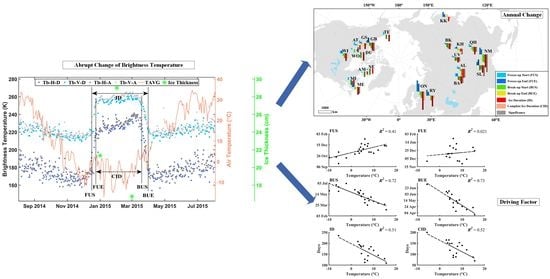Variation in Ice Phenology of Large Lakes over the Northern Hemisphere Based on Passive Microwave Remote Sensing Data
Abstract
1. Introduction
2. Data
2.1. Study Area
2.2. Passive Microwave Remote Sensing Data
2.3. Auxiliary Data
3. Methods
3.1. Lake Ice Phenology Retrieval from Passive Microwave Remote Sensing Brightness Temperature (Tb) Data
- From August to December 2014, air temperature and Tb of Qinghai Lake both gradually decreased, but air temperature decreased faster;
- Tb started to increase rapidly on December 13, which was the FUS. When Tb stabilized after a few days, the first date (23 December 2014) of the steady period was the FUE;
- From January to March 2015, as ice thickness grew after the lake froze, the polarization difference decreased, and the Tb of the lake continued to increase slowly. On March 16, when the lake ice began to melt, the Tb started to decrease. Thus, March 16 is the BUS, from which Tb decreased with ice melting and air temperature increased until April 3; the BUE was recorded when the lake ice melted completely;
- After April 3, Tb remained low while air temperature increased rapidly.
3.2. Validation Index
3.3. Prediction
4. Results
4.1. Variation of Lake Ice Phenology, 1979–2018
4.2. Driving Factors
4.3. Variation of Lake Ice Phenology in the Future
5. Discussion
5.1. Validation with Site Observation
5.2. Comparison with Remote Sensing Products
6. Conclusions
Author Contributions
Funding
Institutional Review Board Statement
Informed Consent Statement
Data Availability Statement
Acknowledgments
Conflicts of Interest
Appendix A
| Lake Name | Pixel ID | Latitude | Longitude |
|---|---|---|---|
| Lake Baikal | BK-1 | 55.341° N | 109.520° E |
| BK-2 | 55.123° N | 109.427° E | |
| BK-3 | 54.819° N | 109.306° E | |
| BK-4 | 54.562° N | 109.170° E | |
| BK-5 | 54.303° N | 109.047° E | |
| BK-6 | 54.073° N | 108.785° E | |
| BK-7 | 53.874° N | 108.510° E | |
| BK-8 | 53.192° N | 108.003° E | |
| BK-9 | 53.006° N | 107.789° E | |
| BK-10 | 52.878° N | 107.511° E | |
| BK-11 | 52.814° N | 107.204° E | |
| BK-12 | 52.731° N | 106.922° E | |
| BK-13 | 52.375° N | 106.169° E | |
| BK-14 | 52.110° N | 105.951° E | |
| BK-15 | 51.928° N | 105.680° E | |
| BK-16 | 51.796° N | 105.391° E | |
| BK-17 | 51.714° N | 105.055° E | |
| BK-18 | 51.639° N | 104.348° E | |
| Great Bear Lake | GB-1 | 66.614° N | 120.829° W |
| GB-2 | 65.783° N | 120.805° W | |
| GB-3 | 65.285° N | 122.325° W | |
| GB-4 | 66.092° N | 118.288° W | |
| Great Slave Lake | GS-1 | 62.151° N | 114.561° W |
| GS-2 | 61.628° N | 113.587° W | |
| GS-3 | 61.035° N | 115.605° W | |
| GS-4 | 61.415° N | 114.513° W | |
| Lake Winnipeg | WI-1 | 53.535° N | 98.457° W |
| WI-2 | 52.447° N | 97.617° W | |
| Balkhash Lake | BA-1 | 46.376° N | 74.600° E |
| BA-2 | 45.792° N | 73.935° E |
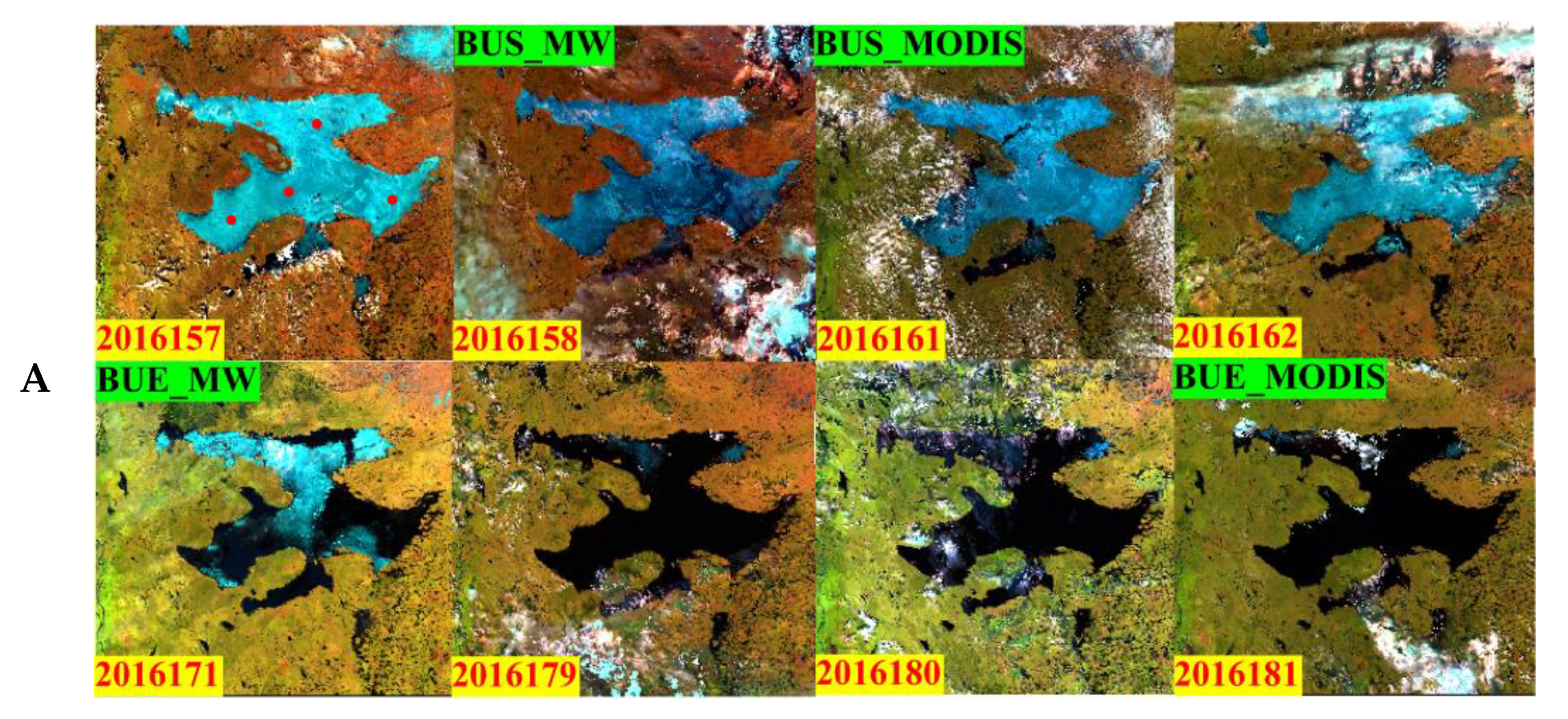
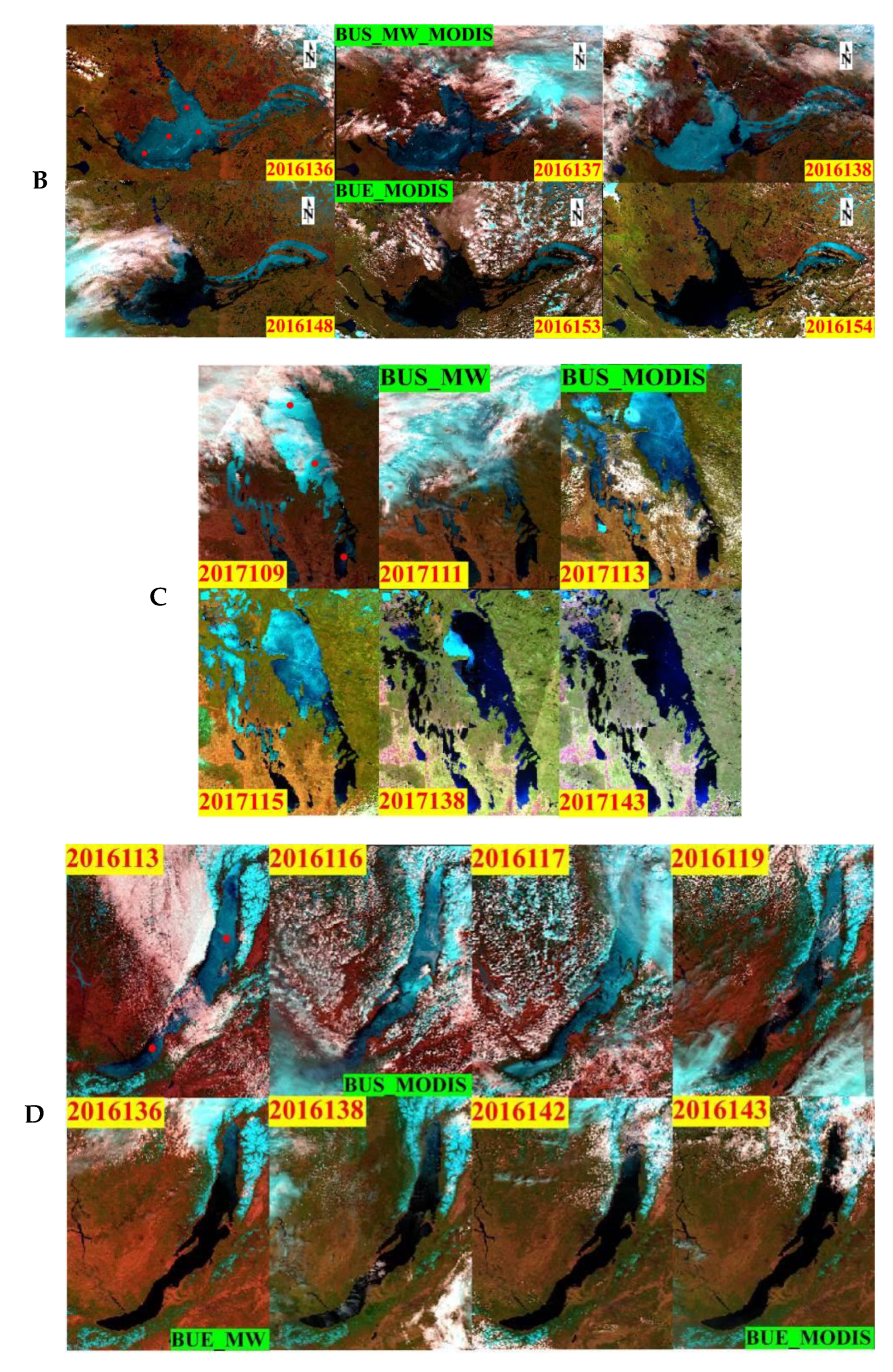
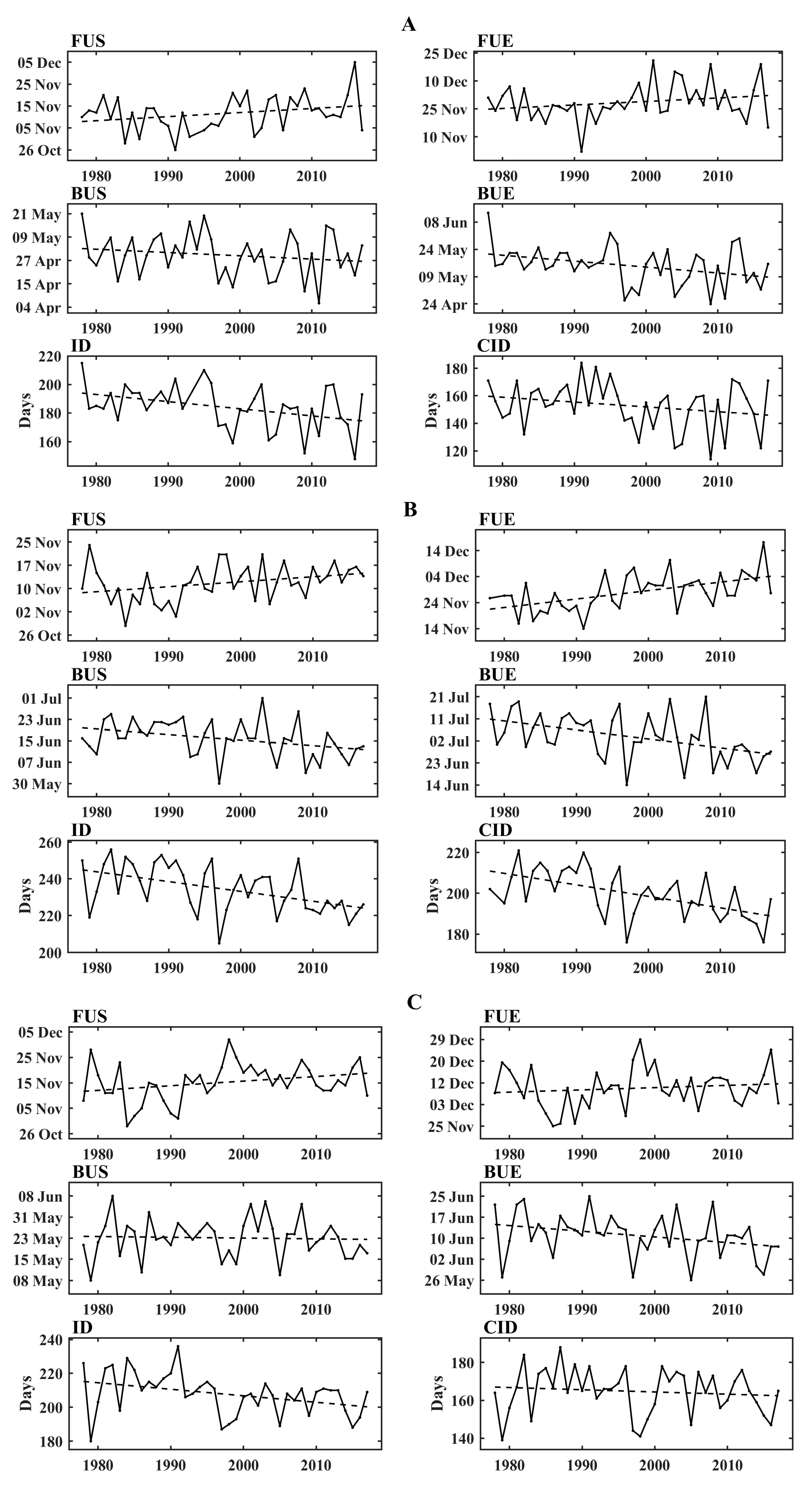
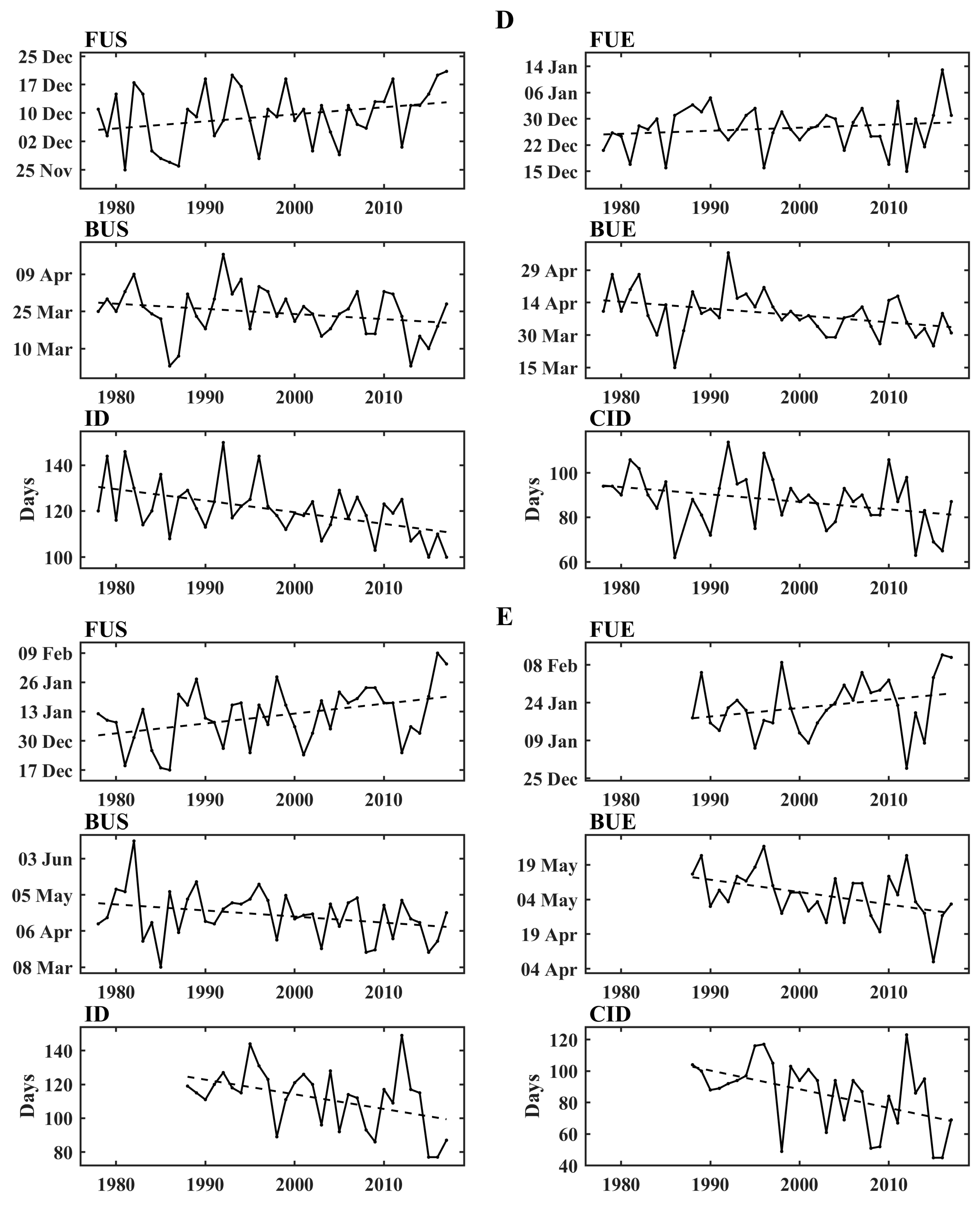


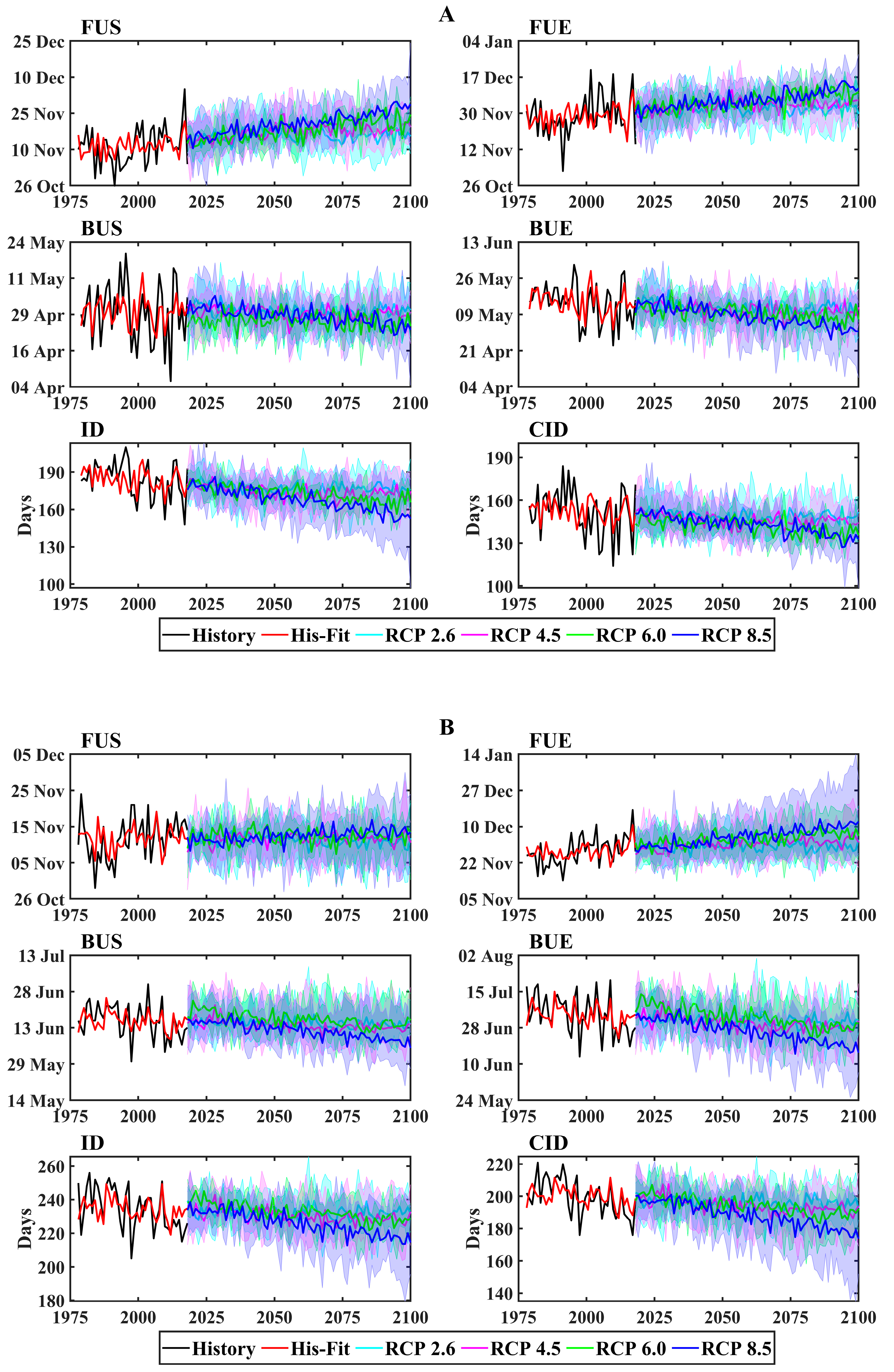
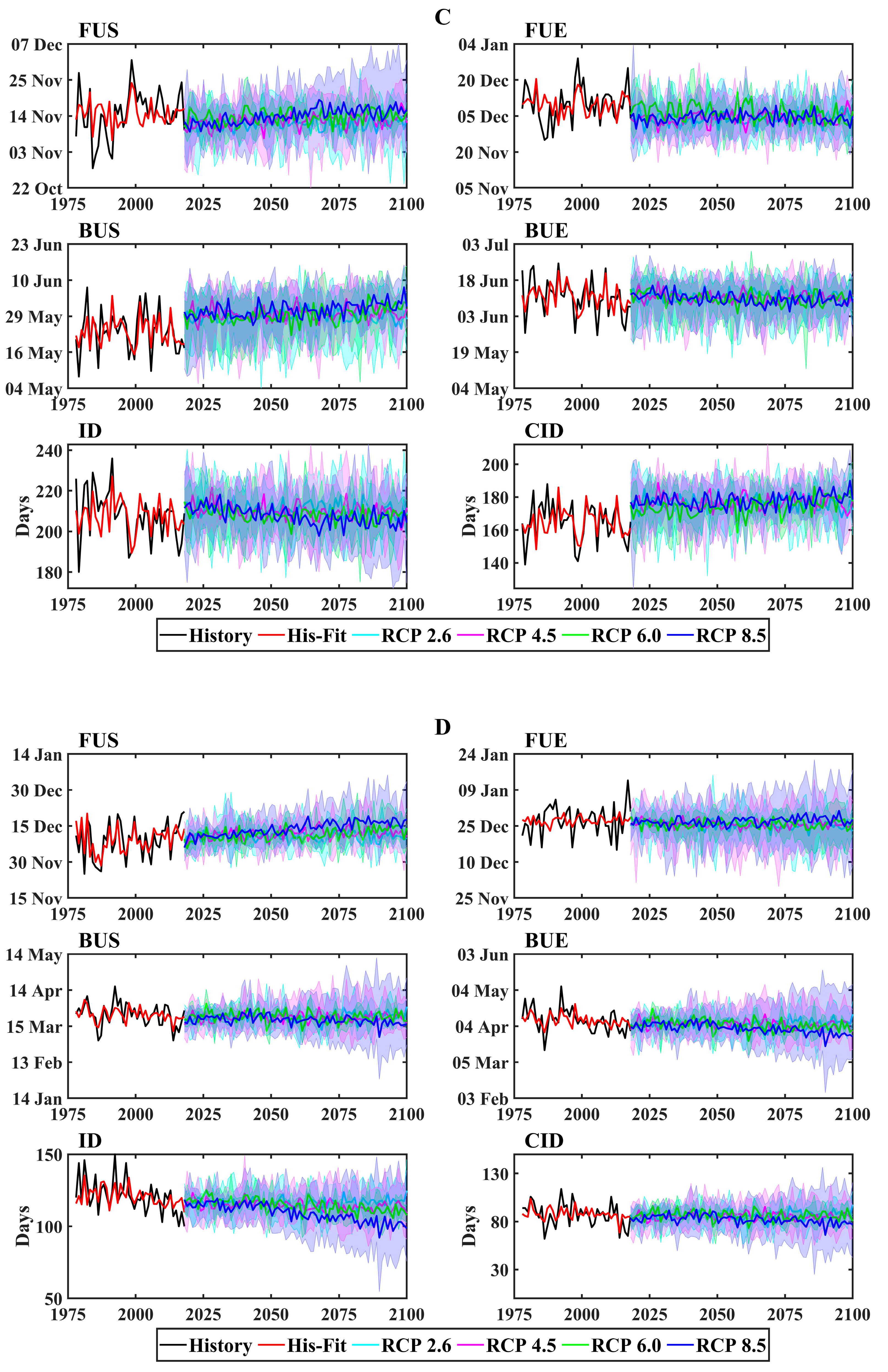
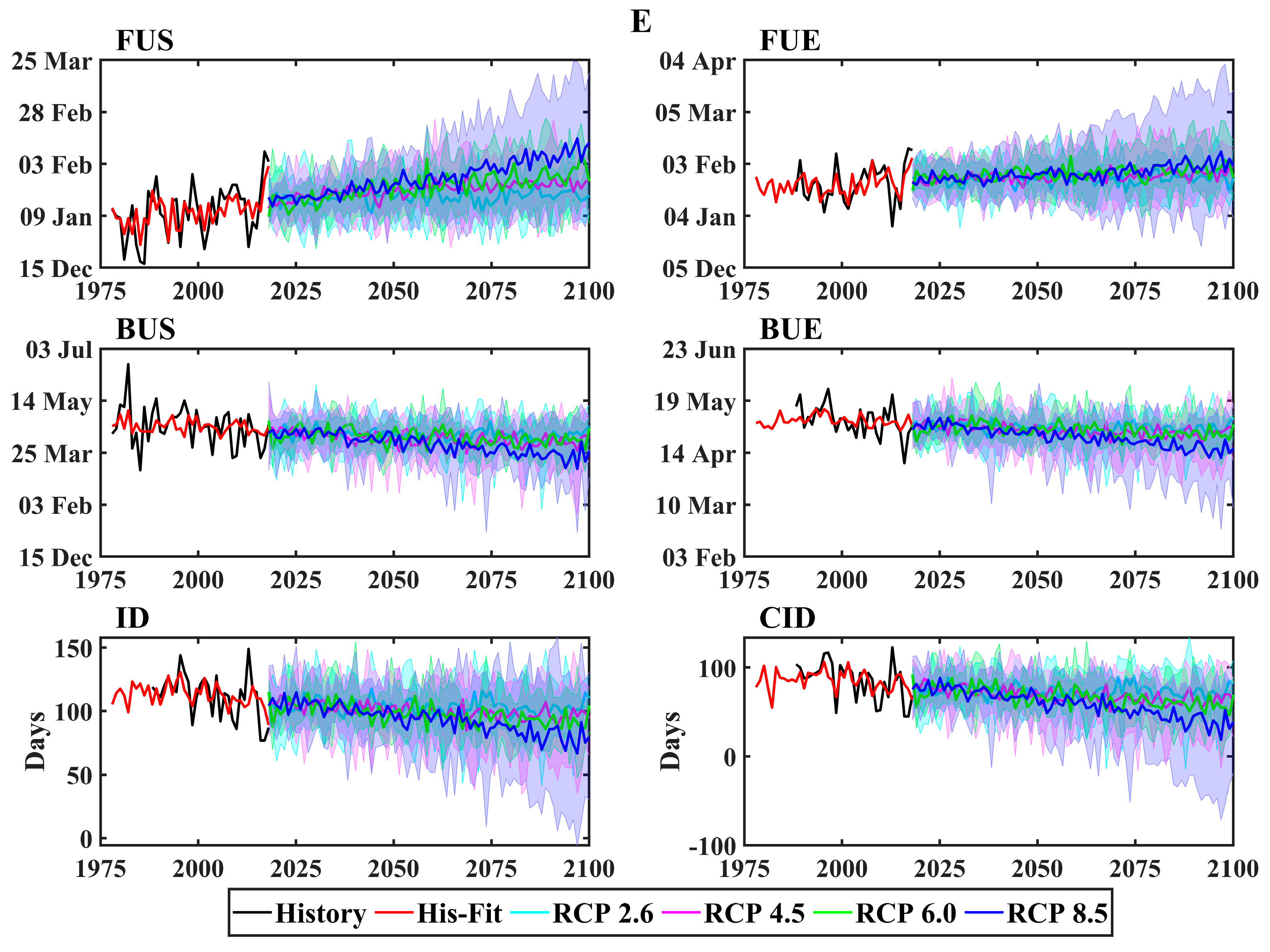
References
- Pachauri, R.K.; Allen, M.R.; Barros, V.R.; Broome, J.; Cramer, W.; Christ, R.; Church, J.A.; Clarke, L.; Dahe, Q.; Dasgupta, P.; et al. IPCC, 2014: Climate Change 2014: Synthesis Report; Contribution of Working Groups I, II and III to the Fifth Assessment Report of the Intergovernmental Panel on Climate Change; IPCC: Geneva, Switzerland, 2014; p. 151. [Google Scholar]
- World Meteorological Organization. The Global Observing System For Climate: Implementation Needs (GCOS-200). In GCOS 2016 Implementation Plan; World Meteorological Organization: Geneva, Switzerland, 2016; p. 9. [Google Scholar]
- Brown, L.C.; Duguay, C.R. The response and role of ice cover in lake-climate interactions. Prog. Phys. Geog. 2010, 34, 671–704. [Google Scholar] [CrossRef]
- Duguay, C.R.; Prowse, T.D.; Bonsal, B.R.; Brown, R.D.; Lacroix, M.P.; Menard, P. Recent trends in Canadian lake ice cover. Hydrol. Process. 2006, 20, 781–801. [Google Scholar] [CrossRef]
- Williams, G.P. Predicting the Date of Lake Ice Breakup. Water Resour. Res. 1971, 7, 323–333. [Google Scholar] [CrossRef]
- Livingstone, D.M. Break-up dates of Alpine lakes as proxy data for local and regional mean surface air temperatures. Clim. Chang. 1997, 37, 407–439. [Google Scholar] [CrossRef]
- Weber, H.; Riffler, M.; Noges, T.; Wunderle, S. Lake ice phenology from AVHRR data for European lakes: An automated two-step extraction method. Remote Sens. Environ. 2016, 174, 329–340. [Google Scholar] [CrossRef]
- Adrian, R.; O’Reilly, C.M.; Zagarese, H.; Baines, S.B.; Hessen, D.O.; Keller, W.; Livingstone, D.M.; Sommaruga, R.; Straile, D.; Van Donk, E.; et al. Lakes as sentinels of climate change. Limnol. Oceanogr. 2009, 54, 2283–2297. [Google Scholar] [CrossRef] [PubMed]
- Duguay, C.R.; Bernier, M.; Gauthier, Y.; Kouraev, A. Remote sensing of lake and river ice. In Remote Sensing of the Cryosphere; Wiley Blackwell: Hoboken, NJ, USA, 2015; pp. 273–306. [Google Scholar] [CrossRef]
- Mishra, V.; Cherkauer, K.A.; Bowling, L.C.; Huber, M. Lake Ice phenology of small lakes: Impacts of climate variability in the Great Lakes region. Glob. Planet. Chang. 2011, 76, 166–185. [Google Scholar] [CrossRef]
- Du, J.Y.; Kimball, J.S.; Duguay, C.; Kim, Y.; Watts, J.D. Satellite microwave assessment of Northern Hemisphere lake ice phenology from 2002 to 2015. Cryosphere 2017, 11, 47–63. [Google Scholar] [CrossRef]
- Magnuson, J.J.; Robertson, D.M.; Benson, B.J.; Wynne, R.H.; Livingstone, D.M.; Arai, T.; Assel, R.A.; Barry, R.G.; Card, V.; Kuusisto, E.; et al. Historical trends in lake and river ice cover in the Northern Hemisphere. Science 2000, 289, 1743–1746. [Google Scholar] [CrossRef]
- Latifovic, R.; Pouliot, D. Analysis of climate change impacts on lake ice phenology in Canada using the historical satellite data record. Remote Sens. Environ. 2007, 106, 492–507. [Google Scholar] [CrossRef]
- Prowse, T.; Alfredsen, K.; Beltaos, S.; Bonsal, B.; Duguay, C.; Korhola, A.; McNamara, J.; Pienitz, R.; Vincent, W.F.; Vuglinsky, V.; et al. Past and Future Changes in Arctic Lake and River Ice. Ambio 2011, 40, 53–62. [Google Scholar] [CrossRef]
- Howell, S.E.L.; Brown, L.C.; Kang, K.K.; Duguay, C.R. Variability in ice phenology on Great Bear Lake and Great Slave Lake, Northwest Territories, Canada, from SeaWinds/QuikSCAT: 2000–2006. Remote Sens. Environ. 2009, 113, 816–834. [Google Scholar] [CrossRef]
- Kang, K.K.; Duguay, C.R.; Howell, S.E.L. Estimating ice phenology on large northern lakes from AMSR-E: Algorithm development and application to Great Bear Lake and Great Slave Lake, Canada. Cryosphere 2012, 6, 235–254. [Google Scholar] [CrossRef]
- Che, T.; Li, X.; Jin, R. Monitoring the frozen duration of Qinghai Lake using satellite passive microwave remote sensing low frequency data. Chin. Sci. Bull. 2009, 54, 2294–2299. [Google Scholar] [CrossRef]
- Ke, C.Q.; Tao, A.Q.; Jin, X. Variability in the ice phenology of Nam Co Lake in central Tibet from scanning multichannel microwave radiometer and special sensor microwave/imager: 1978 to 2013. J. Appl. Remote Sens. 2013, 7. [Google Scholar] [CrossRef]
- Yao, X.J.; Li, L.; Zhao, J.; Sun, M.P.; Li, J.; Gong, P.; An, L.N. Spatial-temporal variations of lake ice phenology in the Hoh Xil region from 2000 to 2011. J. Geogr. Sci. 2016, 26, 70–82. [Google Scholar] [CrossRef]
- Qiu, Y.; Wang, X.; Ruan, Y.; Xie, P.; Zhong, Y.; Yang, S. Passive microwave remote sensing of lake freeze-thawing over Qinghai-Tibet Plateau. J. Lake Sci. 2018, 30, 1438–1449. (In Chinese) [Google Scholar] [CrossRef]
- Qi, M.M.; Liu, S.Y.; Yao, X.J.; Xie, F.M.; Gao, Y.P. Monitoring the Ice Phenology of Qinghai Lake from 1980 to 2018 Using Multisource Remote Sensing Data and Google Earth Engine. Remote Sens. 2020, 12, 2217. [Google Scholar] [CrossRef]
- Gou, P.; Ye, Q.H.; Che, T.; Feng, Q.; Ding, B.H.; Lin, C.G.; Zong, J.B. Lake ice phenology of Nam Co, Central Tibetan Plateau, China, derived from multiple MODIS data products. J. Great Lakes Res. 2017, 43, 989–998. [Google Scholar] [CrossRef]
- Veillette, J.; Muir, D.C.G.; Antoniades, D.; Small, J.M.; Spencer, C.; Loewen, T.N.; Babaluk, J.A.; Reist, J.D.; Vincent, W.F. Perfluorinated Chemicals in Meromictic Lakes on the Northern Coast of Ellesmere Island, High Arctic Canada. Arctic 2012, 65, 245–256. [Google Scholar] [CrossRef][Green Version]
- Wrona, F.J.; Johansson, M.; Culp, J.M.; Jenkins, A.; Mard, J.; Myers-Smith, I.H.; Prowse, T.D.; Vincent, W.F.; Wookey, P.A. Transitions in Arctic ecosystems: Ecological implications of a changing hydrological regime. J. Geophys. Res. Biogeo 2016, 121, 650–674. [Google Scholar] [CrossRef]
- Greene, S.; Anthony, K.M.W.; Archer, D.; Sepulveda-Jauregui, A.; Martinez-Cruz, K. Modeling the impediment of methane ebullition bubbles by seasonal lake ice. Biogeosciences 2014, 11, 6791–6811. [Google Scholar] [CrossRef]
- Weyhenmeyer, G.A.; Livingstone, D.M.; Meili, M.; Jensen, O.; Benson, B.; Magnuson, J.J. Large geographical differences in the sensitivity of ice-covered lakes and rivers in the Northern Hemisphere to temperature changes. Glob. Change Biol. 2011, 17, 268–275. [Google Scholar] [CrossRef]
- Sharma, S.; Blagrave, K.; Magnuson, J.J.; O’Reilly, C.M.; Oliver, S.; Batt, R.D.; Magee, M.R.; Straile, D.; Weyhenmeyer, G.A.; Winslow, L.; et al. Widespread loss of lake ice around the Northern Hemisphere in a warming world. Nat. Clim. Change 2019, 9, 227–231. [Google Scholar] [CrossRef]
- Schroter, D.; Cramer, W.; Leemans, R.; Prentice, I.C.; Araujo, M.B.; Arnell, N.W.; Bondeau, A.; Bugmann, H.; Carter, T.R.; Gracia, C.A.; et al. Ecosystem service supply and vulnerability to global change in Europe. Science 2005, 310, 1333–1337. [Google Scholar] [CrossRef] [PubMed]
- Todd, M.C.; Mackay, A.W. Large-scale climatic controls on Lake Baikal ice cover. J. Clim. 2003, 16, 3186–3199. [Google Scholar] [CrossRef]
- Kouraev, A.V.; Semovski, S.V.; Shimaraev, M.N.; Mognard, N.M.; Legresy, B.; Remy, F. Observations of Lake Baikal ice from satellite altimetry and radiometry. Remote Sens. Environ. 2007, 108, 240–253. [Google Scholar] [CrossRef]
- Benson, B.J.; Magnuson, J.J.; Jensen, O.P.; Card, V.M.; Hodgkins, G.; Korhonen, J.; Livingstone, D.M.; Stewart, K.M.; Weyhenmeyer, G.A.; Granin, N.G. Extreme events, trends, and variability in Northern Hemisphere lake-ice phenology (1855–2005). Clim. Change 2012, 112, 299–323. [Google Scholar] [CrossRef]
- Liston, G.E.; Hall, D.K. Sensitivity of lake freeze-up and break-up to climate change: A physically based modeling study. Ann. Glaciol. 1995, 21, 387–393. [Google Scholar] [CrossRef][Green Version]
- Walsh, S.E.; Vavrus, S.J.; Foley, J.A.; Fisher, V.A.; Wynne, R.H.; Lenters, J.D. Global patterns of lake ice phenology and climate: Model simulations and observations. J. Geophys. Res. Atmos. 1998, 103, 28825–28837. [Google Scholar] [CrossRef]
- O’Reilly, C.M.; Sharma, S.; Gray, D.K.; Hampton, S.E.; Read, J.S.; Rowley, R.J.; Schneider, P.; Lenters, J.D.; McIntyre, P.B.; Kraemer, B.M.; et al. Rapid and highly variable warming of lake surface waters around the globe. Geophys. Res. Lett. 2015, 42, 10773–10781. [Google Scholar] [CrossRef]
- Menard, P.; Duguay, C.R.; Flato, G.M.; Rouse, W.R. Simulation of ice phenology on Great Slave Lake, Northwest Territories, Canada. Hydrol. Process. 2002, 16, 3691–3706. [Google Scholar] [CrossRef]
- Qi, M.M.; Yao, X.J.; Li, X.F.; Duan, H.Y.; Gao, Y.P.; Liu, J. Spatiotemporal characteristics of Qinghai Lake ice phenology between 2000 and 2016. J. Geogr. Sci. 2019, 29, 115–130. [Google Scholar] [CrossRef]
- Wilson, J.W. Effect of Lake-Ontario on Precipitation. Mon. Weather. Rev. 1977, 105, 207–214. [Google Scholar] [CrossRef]
- Zhang, G.; Chen, W.; Li, G.; Yang, W.; Yi, S.; Luo, W. Lake water and glacier mass gains in the northwestern Tibetan Plateau observed from multi-sensor remote sensing data: Implication of an enhanced hydrological cycle. Remote Sens. Environ. 2020, 237, 111554. [Google Scholar] [CrossRef]
- Liu, Y.; Chen, H.P.; Li, H.X.; Wang, H.J. The Impact of Preceding Spring Antarctic Oscillation on the Variations of Lake Ice Phenology over the Tibetan Plateau. J. Clim. 2020, 33, 639–656. [Google Scholar] [CrossRef]
- Liu, Y.; Chen, H.P.; Wang, H.J.; Qiu, Y.B. The Impact of the NAO on the Delayed Break-Up Date of Lake Ice over the Southern Tibetan Plateau. J. Clim. 2018, 31, 9073–9086. [Google Scholar] [CrossRef]
- Park, H.; Yoshikawa, Y.; Oshima, K.; Kim, Y.; Thanh, N.D.; Kimball, J.S.; Yang, D.Q. Quantification of Warming Climate-Induced Changes in Terrestrial Arctic River Ice Thickness and Phenology. J. Clim. 2016, 29, 1733–1754. [Google Scholar] [CrossRef]
- Yang, X.; Pavelsky, T.M.; Allen, G.H. The past and future of global river ice. Nature 2020, 577, 69–73. [Google Scholar] [CrossRef]
- Dibike, Y.; Prowse, T.; Bonsal, B.; de Rham, L.; Saloranta, T. Simulation of North American lake-ice cover characteristics under contemporary and future climate conditions. Int. J. Clim. 2012, 32, 695–709. [Google Scholar] [CrossRef]
- Sharma, S.; Magnuson, J.J.; Batt, R.D.; Winslow, L.A.; Korhonen, J.; Aono, Y. Direct observations of ice seasonality reveal changes in climate over the past 320–570 years. Sci. Rep. 2016, 6, 25061. [Google Scholar] [CrossRef]
- Chaouch, N.; Temimi, M.; Romanov, P.; Cabrera, R.; McKillop, G.; Khanbilvardi, R. An automated algorithm for river ice monitoring over the Susquehanna River using the MODIS data. Hydrol. Process. 2014, 28, 62–73. [Google Scholar] [CrossRef]
- Kropacek, J.; Maussion, F.; Chen, F.; Hoerz, S.; Hochschild, V. Analysis of ice phenology of lakes on the Tibetan Plateau from MODIS data. Cryosphere 2013, 7, 287–301. [Google Scholar] [CrossRef]
- Liu, X.D.; Chen, B.D. Climatic warming in the Tibetan Plateau during recent decades. Int. J. Clim. 2000, 20, 1729–1742. [Google Scholar] [CrossRef]
- Shiklomanov, A.I.; Lammers, R.B.; Vörösmarty, C.J. Widespread decline in hydrological monitoring threatens Pan-Arctic Research. EOS 2002, 83, 13–17. [Google Scholar] [CrossRef]
- Richard, S.; Williams, J.; Ferrigno, G. State of the Earth’s Cryosphere at the Beginning of the 21st Century—Glaciers, Global Snow Cover, Floating Ice, and Permafrost and Periglacial Environments; U.S. Geological Survey; US Government: Washington, DC, USA, 2012; 546p.
- Lenormand, F.; Duguay, C.R.; Gauthier, R. Development of a historical ice database for the study of climate change in Canada. Hydrol. Process. 2002, 16, 3707–3722. [Google Scholar] [CrossRef]
- Nonaka, T.; Matsunaga, T.; Hoyano, A. Estimating ice breakup dates on Eurasian lakes using water temperature trends and threshold surface temperatures derived from MODIS data. Int. J. Remote Sens. 2007, 28, 2163–2179. [Google Scholar] [CrossRef]
- Hall, D.K.; Riggs, G.A.; Foster, J.L.; Kumar, S.V. Development and evaluation of a cloud-gap-filled MODIS daily snow-cover product. Remote Sens. Environ. 2010, 114, 496–503. [Google Scholar] [CrossRef]
- Hall, D.K.; Riggs, G.A. Accuracy assessment of the MODIS snow products. Hydrol. Process. 2007, 21, 1534–1547. [Google Scholar] [CrossRef]
- Pour, H.K.; Duguay, C.R.; Martynov, A.; Brown, L.C. Simulation of surface temperature and ice cover of large northern lakes with 1-D models: A comparison with MODIS satellite data and in situ measurements. Tellus A Dyn. Meteorol. Oceanogr. 2012, 64. [Google Scholar] [CrossRef]
- Cai, Y.; Ke, C.Q.; Li, X.G.; Zhang, G.Q.; Duan, Z.; Lee, H. Variations of Lake Ice Phenology on the Tibetan Plateau From 2001 to 2017 Based on MODIS Data. J. Geophys. Res. Atmos 2019, 124, 825–843. [Google Scholar] [CrossRef]
- Zhang, S.; Pavelsky, T.M. Remote Sensing of Lake Ice Phenology across a Range of Lakes Sizes, ME, USA. Remote Sens. 2019, 11, 1718. [Google Scholar] [CrossRef]
- Gafurov, A.; Bardossy, A. Cloud removal methodology from MODIS snow cover product. Hydrol. Earth Syst. Sci. 2009, 13, 1361–1373. [Google Scholar] [CrossRef]
- Maslanik, J.A.; Barry, R.G. The Influence of Climate Change and Climatic Variability on the Hydrologie Regime and Water Resources. In Proceedings of the Vancouver Symposium, Vancouver, BC, Canada, 9–22 August 1987. [Google Scholar]
- Jeffries, M.O.; Morris, K.; Kozlenko, N. Ice Characteristics and Processes, and Remote Sensing of Frozen Rivers and Lakes; American Geophysical Union: Washington, DC, USA, 2005. [Google Scholar]
- Smejkalova, T.; Edwards, M.E.; Dash, J. Arctic lakes show strong decadal trend in earlier spring ice-out. Sci. Rep. 2016, 6. [Google Scholar] [CrossRef] [PubMed]
- Hoekstra, M.; Jiang, M.Z.; Clausi, D.A.; Duguay, C. Lake Ice-Water Classification of RADARSAT-2 Images by Integrating IRGS Segmentation with Pixel-Based Random Forest Labeling. Remote Sens. 2020, 12, 1425. [Google Scholar] [CrossRef]
- Tom, M.; Kälin, U.; Sütterlin, M.; Baltsavias, E.; Schindler, K. Lake Ice Detection in Low-Resolution Optical Stellite Images. ISPR.S Ann. Photogramm. Remote Sens. Spat. Inf. Sci. 2018, IV-2, 279–286. [Google Scholar] [CrossRef]
- Wu, Y.; Duguay, C.R.; Xu, L. Assessment of machine learning classifiers for global lake ice cover mapping from MODIS TOA reflectance data. Remote Sens. Environ. 2021, 253, 112206. [Google Scholar] [CrossRef]
- Jeffries, M.O.; Morris, K.; Weeks, W.F.; Wakabayashi, H. Structural and Stratigraphic Features and Ers-1 Synthetic-Aperture Radar Backscatter Characteristics of Ice Growing on Shallow Lakes in Nw Alaska, Winter 1991–1992. J. Geophys. Res. Ocean. 1994, 99, 22459–22471. [Google Scholar] [CrossRef]
- Duguay, C.R.; Pultz, T.J.; Lafleur, P.M.; Drai, D. RADARSAT backscatter characteristics of ice growing on shallow sub-Arctic lakes, Churchill, Manitoba, Canada. Hydrol. Process. 2002, 16, 1631–1644. [Google Scholar] [CrossRef]
- Duguay, C.R.; Lafleur, P.M. Determining depth and ice thickness of shallow sub-Arctic lakes using space-borne optical and SAR data. Int. J. Remote Sens. 2003, 24, 475–489. [Google Scholar] [CrossRef]
- Surdu, C.M.; Duguay, C.R.; Pour, H.K.; Brown, L.C. Ice Freeze-up and Break-up Detection of Shallow Lakes in Northern Alaska with Spaceborne SAR. Remote Sens. 2015, 7, 6133–6159. [Google Scholar] [CrossRef]
- Dornhofer, K.; Oppelt, N. Remote sensing for lake research and monitoring—Recent advances. Ecol. Indic. 2016, 64, 105–122. [Google Scholar] [CrossRef]
- Cavalieri, D.J.; Gloersen, P.; Campbell, W.J. Determination of Sea Ice Parameters with the Nimbus-7 Smmr. J. Geophys. Res. Atmos. 1984, 89, 5355–5369. [Google Scholar] [CrossRef]
- Helfrich, S.R.; McNamara, D.; Ramsay, B.H.; Baldwin, T.; Kasheta, T. Enhancements to, and forthcoming developments in the Interactive Multisensor Snow and Ice Mapping System (IMS). Hydrol. Process. 2007, 21, 1576–1586. [Google Scholar] [CrossRef]
- Cai, Y.; Ke, C.Q.; Duan, Z. Monitoring ice variations in Qinghai Lake from 1979 to 2016 using passive microwave remote sensing data. Sci. Total Environ. 2017, 607–608, 120–131. [Google Scholar] [CrossRef] [PubMed]
- Kang, K.K.; Duguay, C.R.; Lemmetyinen, J.; Gel, Y. Estimation of ice thickness on large northern lakes from AMSR-E brightness temperature measurements. Remote Sens. Environ. 2014, 150, 1–19. [Google Scholar] [CrossRef]
- Messager, M.L.; Lehner, B.; Grill, G.; Nedeva, I.; Schmitt, O. Estimating the volume and age of water stored in global lakes using a geo-statistical approach. Nat. Commun. 2016, 7, 13603. [Google Scholar] [CrossRef]
- Lehner, B.; Doll, P. Development and validation of a global database of lakes, reservoirs and wetlands. J. Hydrol. 2004, 296, 1–22. [Google Scholar] [CrossRef]
- Global Lakes and Wetlands Database. Available online: https://www.worldwildlife.org/pages/global-lakes-and-wetlands-database (accessed on 8 March 2021).
- ILEC World Lake Database. Available online: https://wldb.ilec.or.jp/ (accessed on 8 March 2021).
- Global Lake Database. Available online: http://www.worldlakes.org/index.asp (accessed on 8 March 2021).
- Knowles, K.; Njoku, E.G.; Armstrong, R.; Brodzik, M.J. Nimbus-7 SMMR Pathfinder Daily EASE-Grid Brightness Temperatures. Version 1; NASA National Snow and Ice Data Center Distributed Active Archive Center: Boulder, CO, USA, 2000. [CrossRef]
- Armstrong, R.; Knowles, K.; Brodzik, M.J.; Hardman, M.A. DMSP SSM/I-SSMIS Pathfinder Daily EASE-Grid Brightness Temperatures. Version 2; NASA National Snow and Ice Data Center Distributed Active Archive Center: Boulder, CO, USA, 1994. [CrossRef]
- Menne, M.J.I.; Durre, R.S.V.; Gleason, B.E.; Houston, T.G. An overview of the Global Historical Climatology Network-Daily Database. J. Atmos. Ocean. Technol. 2012, 29, 897–910. [Google Scholar] [CrossRef]
- Menne, M.J.; Durre, I.; Korzeniewski, B.; McNeal, S.; Thomas, K.; Yin, X.; Anthony, S.; Ray, R.; Vose, R.S.; Gleason, B.E.; et al. Global Historical Climatology Network—Daily (GHCN-Daily). Version 3.27-upd-2019102718; NOAA National Climatic Data Center: Asheville, NC, USA, 2012. [CrossRef]
- Benson, B.; Magnuson, J.; Sharma, S. Global Lake and River Ice Phenology Database. Version 1; NSIDC—National Snow and Ice Data Center: Boulder, CO, USA, 2020. [Google Scholar] [CrossRef]
- Wang, G.; Zhang, T.; Yang, R.; Zhong, X.; Li, X. Lake ice changes in the Third Pole and the Arctic. J. Glac. Geocryol. 2020, 42, 124–139. [Google Scholar] [CrossRef]
- Skinner, W.R. Lake ice conditions as a cryospheric indicator for detecting climate variability in Canada. In World Data Center A, Glaciology (Snow & Ice); Canadian Climate Centre: Gatineau, QC, Canada, 1993; pp. 204–240. [Google Scholar]
- Qiu, Y.; Guo, H.; Ruan, Y.; Fu, X.; Shi, L.; Bangsen, T. Microwave Brightness Temperature and Freeze-Thaw Datasets for Medium-Large Lakes over the High Asia 2002–2016. V1; Science Data Bank: Beijing, China, 2017; (In Chinese). [Google Scholar] [CrossRef]
- Brodzik, M.J.; Long, D.G.; Hardman, M.A.; Paget, A.; Armstrong, R. MEaSUREs Calibrated Enhanced-Resolution Passive Microwave Daily EASE-Grid 2.0 Brightness Temperature ESDR. Version 1; NASA National Snow and Ice Data Center Distributed Active Archive Center: Boulder, CO, USA, 2020. [CrossRef]
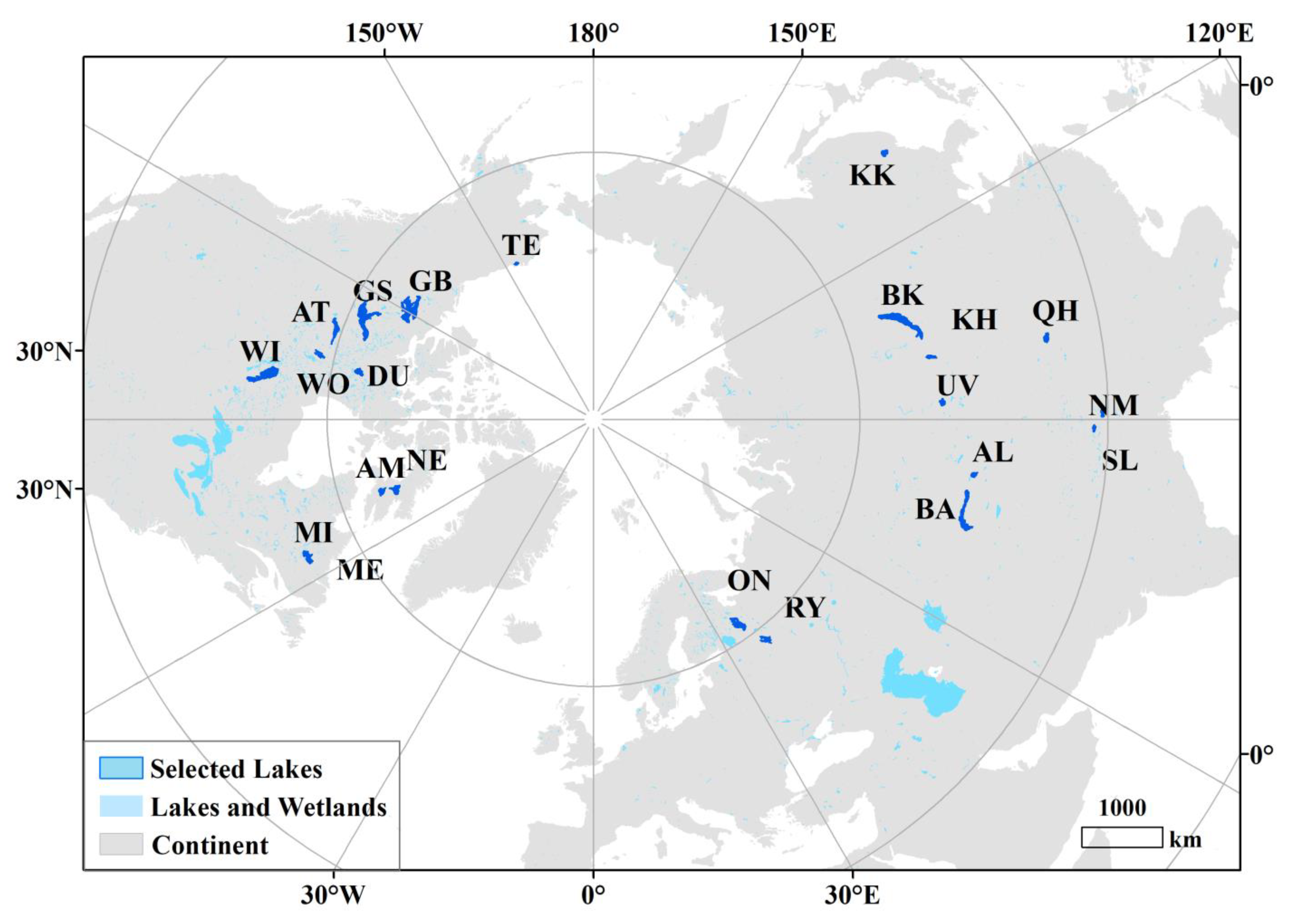

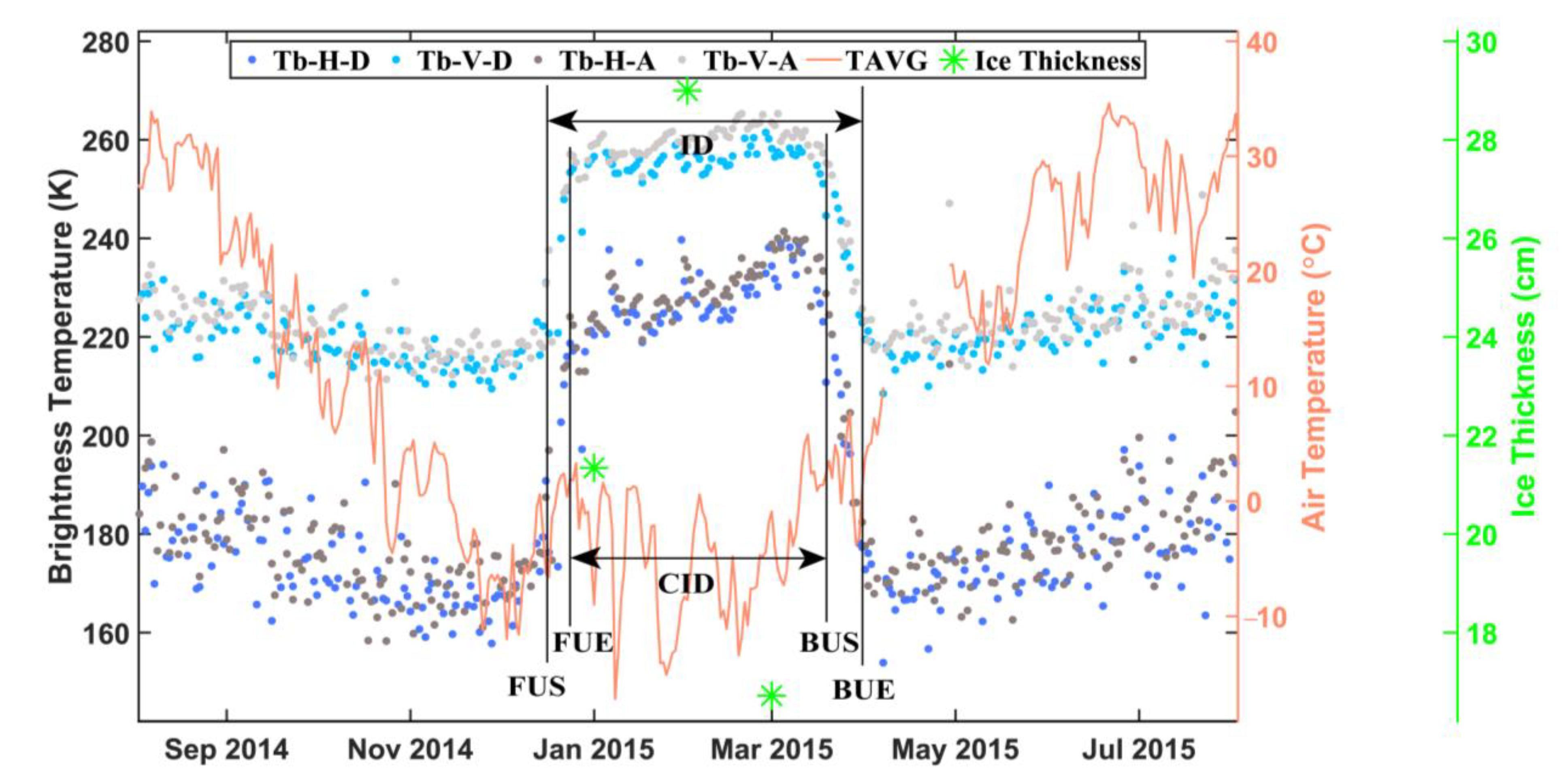
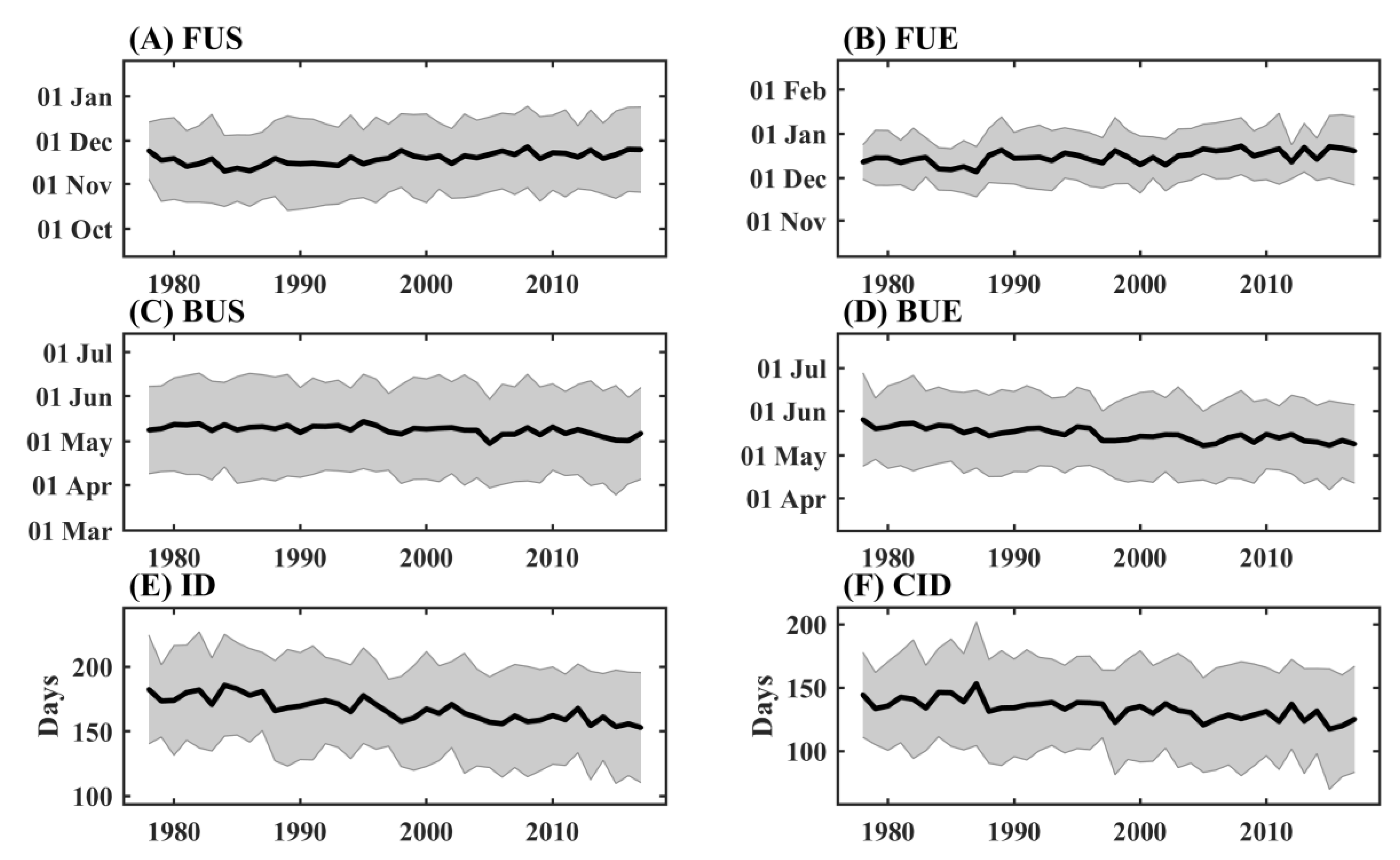
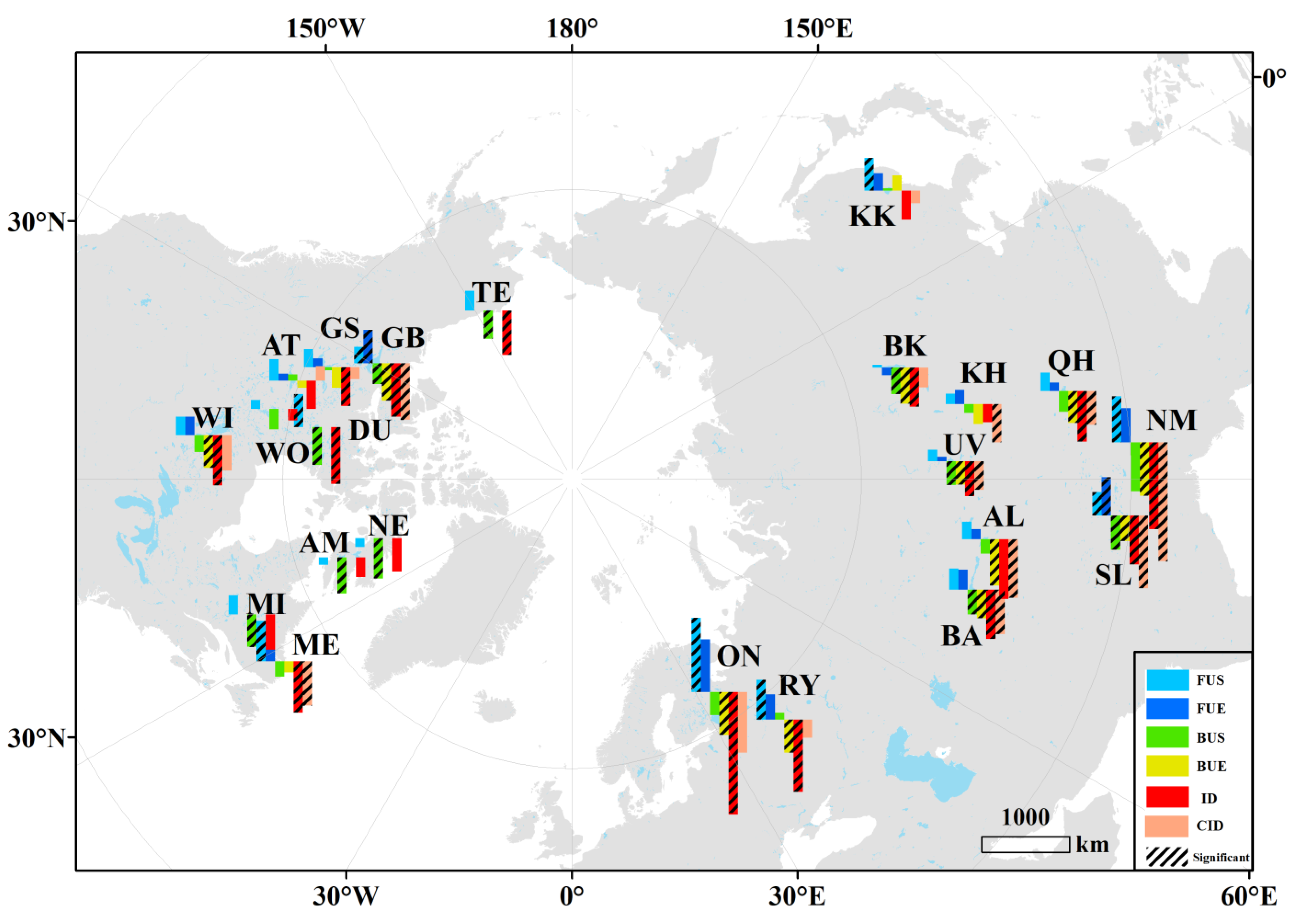
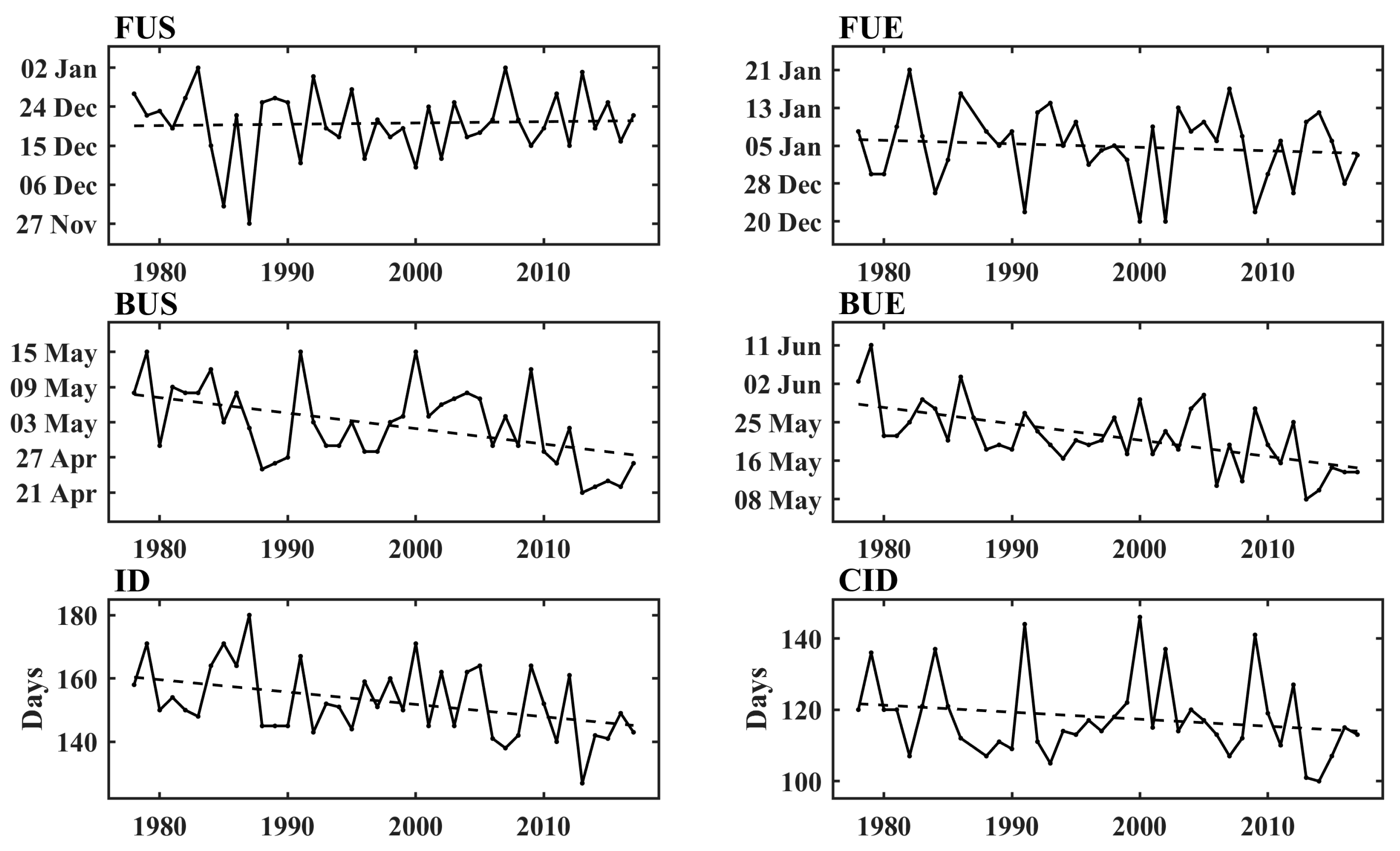
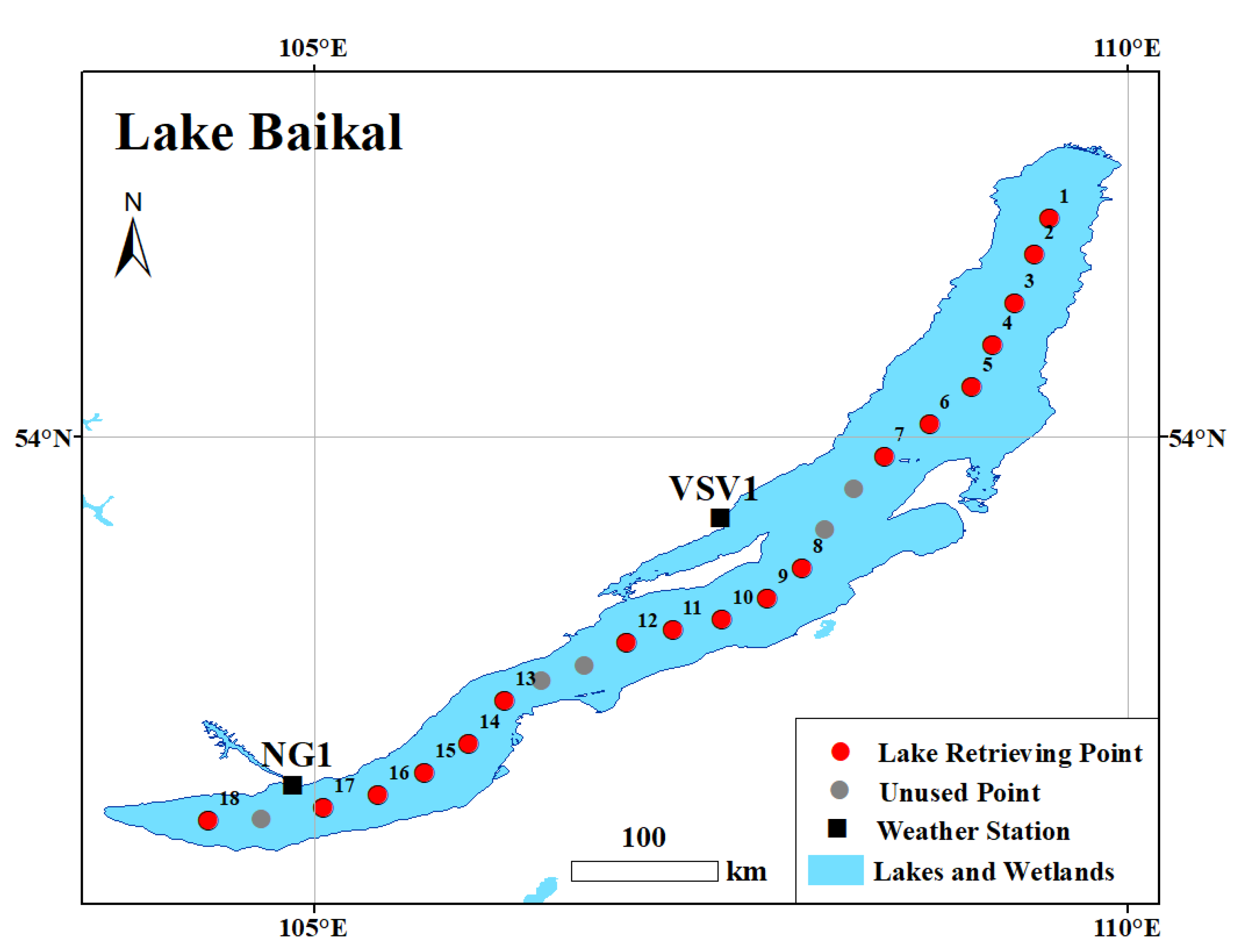
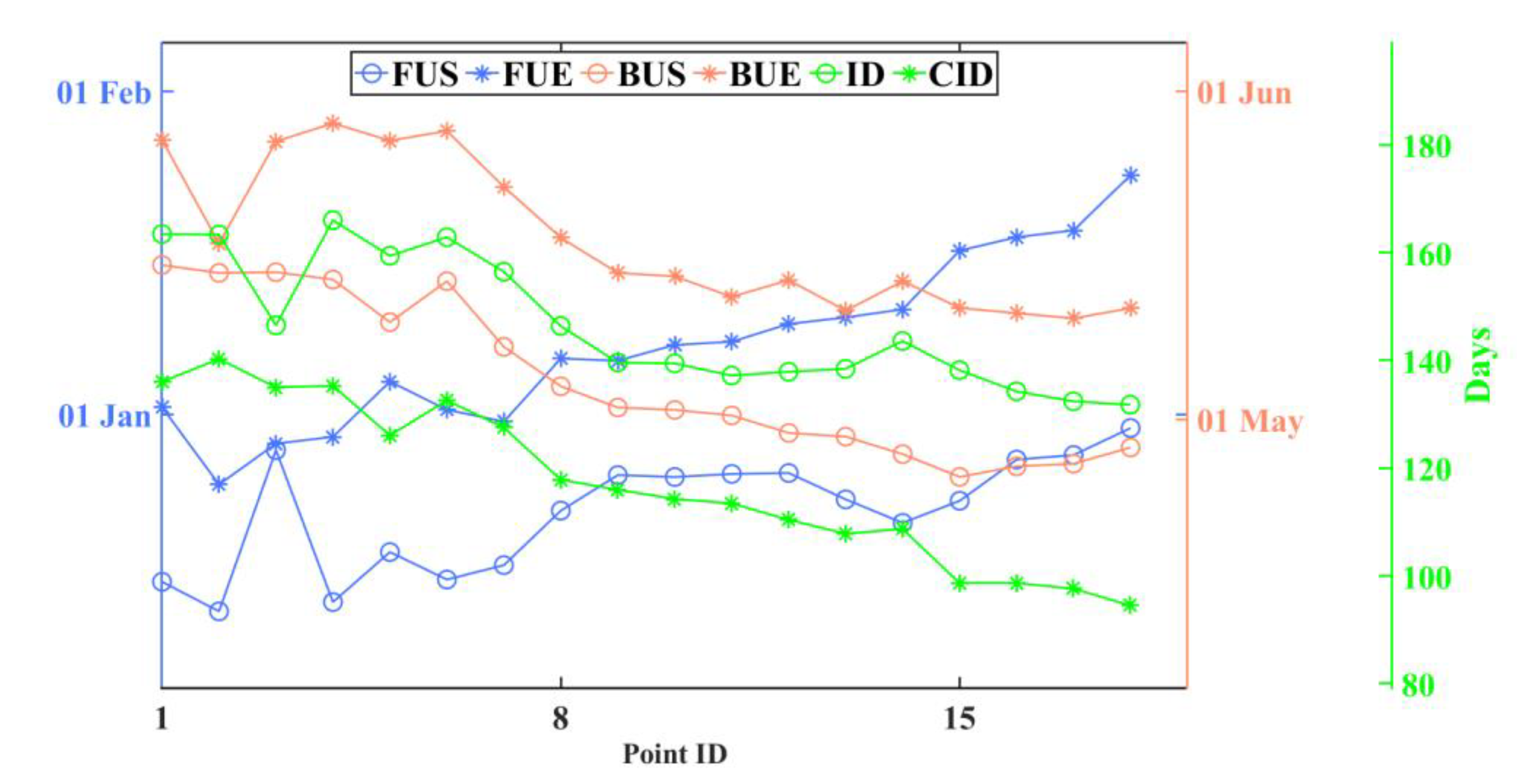


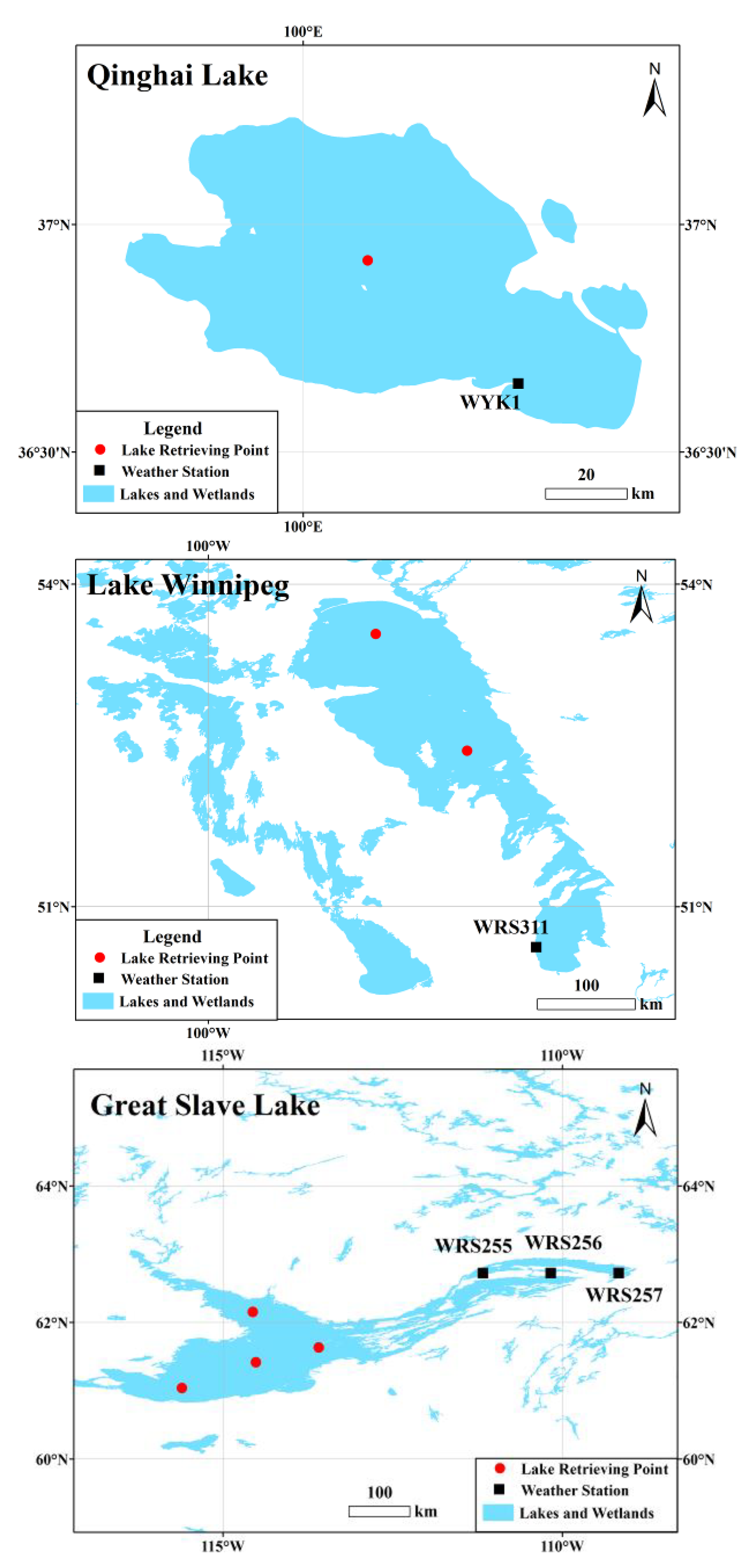
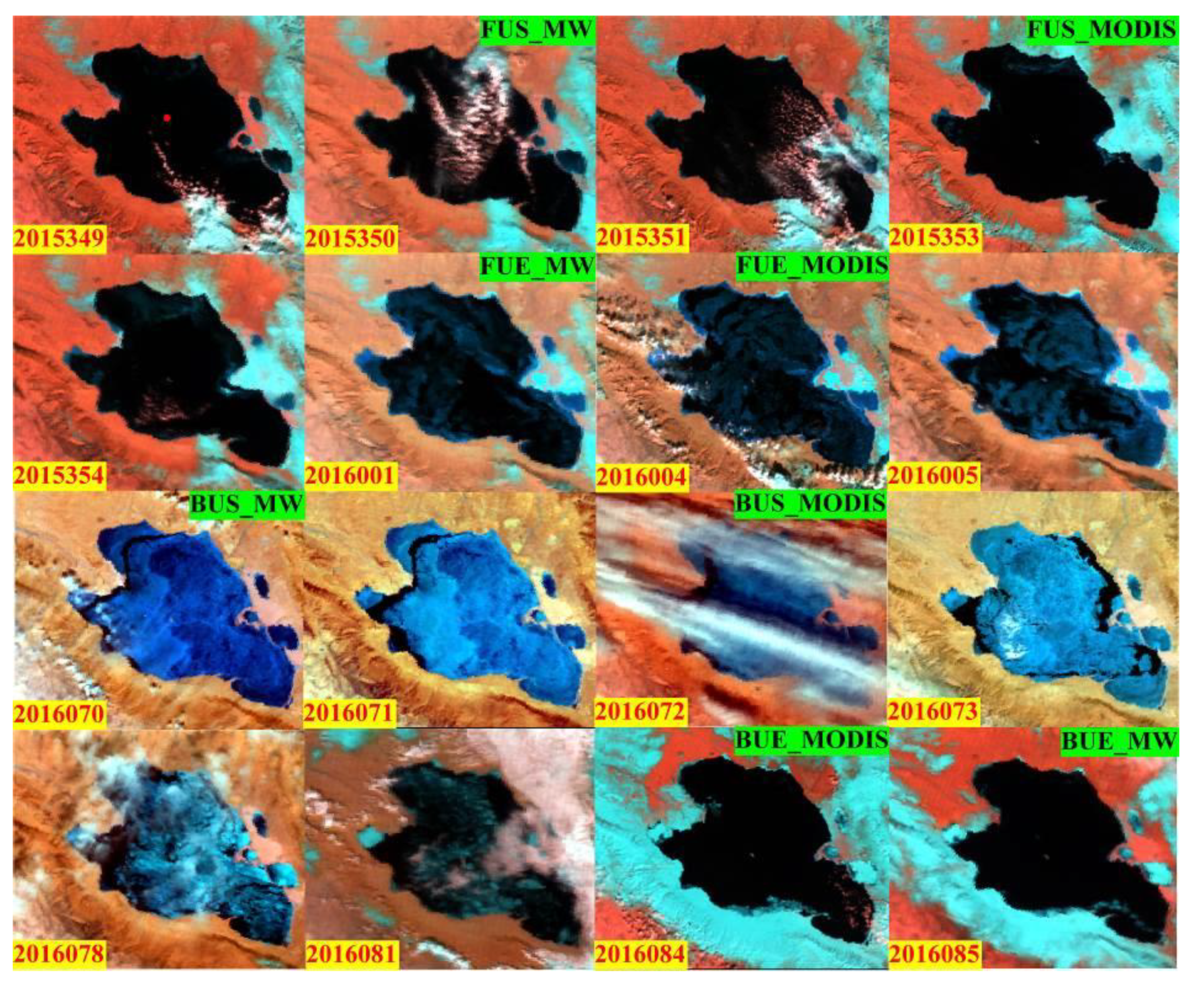
| No. | Lake Name | Abbreviation | Country | Latitude | Longitude | Area (km2) | Altitude (m.a.s.l.) | Adjacent Weather Station ID |
|---|---|---|---|---|---|---|---|---|
| 1 | Baikal | BK | Russia | 54.321° N | 109.006° E | 31,924.6 | 456 | RSM00030636 |
| 2 | Great Bear | GB | Canada | 66.614° N | 120.829° W | 30,530.1 | 186 | CA002300902 |
| 3 | Great Slave | GS | Canada | 62.151° N | 114.561° W | 27,816.3 | 156 | CA002202400 |
| 4 | Winnipeg | WI | Canada | 50.733° N | 96.710° W | 23,809.3 | 217 | CA005022791 |
| 5 | Balkhash | BA | Kazakhstan | 46.376° N | 74.600° E | 17,458.8 | 341 | KZ000035796 |
| 6 | Onega | ON | Russia | 61.582° N | 35.668° E | 9608.1 | 35 | RSM00022831 |
| 7 | Athabasca | AT | Canada | 59.254° N | 109.432° W | 7781.6 | 213 | CA004063755 |
| 8 | Khanka | KK | China and Russia | 45.007° N | 132.416° E | 4088.1 | 69 | RSM00031921 |
| 9 | Qinghai | QH | China | 36.921° N | 100.143° E | 4449.7 | 3196 | CHM00052754 |
| 10 | Khuvsgul | KH | Mongolia | 51.108° N | 100.516° E | 2741.4 | 1645 | MGM00044207 |
| 11 | Uvs | UV | Mongolia | 50.302° N | 92.711°E | 3421.5 | 759 | MG000044212 |
| 12 | Melville | ME | Canada | 53.678° N | 59.632° W | 3069.0 | −1 | CA008501900 |
| 13 | Rybinksk | RY | Russia | 58.414°N | 38.491° E | 3926.6 | 102 | RSM00027037 |
| 14 | Alakol | AL | Kazakhstan | 46.117° N | 81.746° E | 2802.1 | 347 | KZ000036729 |
| 15 | Nam Co | NM | China | 30.666° N | 90.527° E | 1933.6 | 4718 | CHM00055279 |
| 16 | Selin Co | SL | China | 31.739° N | 89.114° E | 1640.9 | 4530 | CHM00055279 |
| 17 | Nettilling | NE | Canada | 66.582° N | 70.852° W | 5064.7 | 30 | CA002401030 |
| 18 | Amadjuak | AM | Canada | 64.898° N | 71.217° W | 3033.7 | 113 | CA002403049 |
| 19 | Dubawnt | DU | Canada | 63.113° N | 101.540° W | 3628.5 | 236 | CA002300500 |
| 20 | Wollaston | WO | Canada | 58.233° N | 103.304° W | 2272.0 | 398 | CA004063755 |
| 21 | Michikamau | MI | Canada | 54.043° N | 63.974° W | 5610.4 | 460 | CA007117827 |
| 22 | Teshekpuk | TE | U.S.A. | 70.605° N | 153.632° W | 834.9 | 2 | CA002300902 |
| Model | Institute | Nation | Spatial Coverage (°) | Representative Concentration Pathways (RCPs) | ||||
|---|---|---|---|---|---|---|---|---|
| Lon. | Lat. | 2.6 | 4.5 | 6 | 8.5 | |||
| CanESM2 | Canadian Centre for Climate Modelling and Analysis | Canada | 2.7906 | 2.8125 | ✓ | ✓ | × | ✓ |
| GFDL-CM3 | Geophysical Fluid Dynamics Laboratory | U.S.A. | 2 | 2.5 | ✓ | ✓ | ✓ | ✓ |
| GFDL-ESM2G | Geophysical Fluid Dynamics Laboratory | U.S.A. | 2.0225 | 2 | ✓ | ✓ | ✓ | ✓ |
| IPSL-CM5A-LR | Institut Pierre Simon Laplace | France | 1.8947 | 3.75 | ✓ | ✓ | ✓ | ✓ |
| MPI-ESM-LR | Max Planck Institute | Germany | 1.8653 | 1.875 | ✓ | ✓ | × | ✓ |
| NorESM1-M | Norwegian Climate Centre | Norway | 1.8947 | 2.5 | ✓ | ✓ | × | ✓ |
| Lake Name | Station ID | FUE | BUE | Data Period | ||||
|---|---|---|---|---|---|---|---|---|
| RMSE | MAE | MBE | RMSE | MAE | MBE | |||
| Baikal | NG1 | 7.32 | 12.70 | −12.70 | 5.33 | 23.90 | 23.90 | 1979–2005 |
| VSV1 | 11.30 | 9.25 | 8.75 | 2.85 | 8.40 | 6.80 | 1982–1987 | |
| Qinghai | WYK1 | 2.99 | 3.60 | 3.60 | 2.11 | 4.80 | 4.80 | 2002–2006 |
| Winnipeg | WRS311 | 7.60 | 5.46 | 0.39 | 4.70 | 8.08 | 7.75 | 1979–1990 |
| Great Slave | WRS255 | 4.49 | 21.20 | 21.20 | 8.05 | 13.20 | −8.17 | 1979–1990 |
| WRS256 | 11.80 | 20.50 | 16.80 | 5.08 | 9.08 | −8.92 | 1979–1990 | |
| WRS257 | 3.29 | 17.70 | 17.70 | 8.29 | 7.00 | −0.60 | 1985–1990 | |
| Average | 6.97 | 12.92 | 7.96 | 5.20 | 10.64 | 3.65 | ||
| Lake Name | FUS | FUE | BUS | BUE | ||||||||
|---|---|---|---|---|---|---|---|---|---|---|---|---|
| MBE | MAE | RMSE | MBE | MAE | RMSE | MBE | MAE | RMSE | MBE | MAE | RMSE | |
| Qinghai | −0.50 | 2.50 | 2.55 | −2.33 | 2.33 | 2.38 | −1.67 | 1.67 | 2.08 | −1.00 | 1.67 | 2.38 |
| Great Bear | NA | NA | NA | NA | NA | NA | −2.33 | 2.33 | 2.52 | −6.50 | 6.50 | 7.38 |
| Great Slave | NA | NA | NA | NA | NA | NA | −2.00 | 2.00 | 3.46 | −2.00 | 2.00 | 2.45 |
| Baikal | NA | NA | NA | NA | NA | NA | −2.67 | 2.67 | 2.83 | −3.50 | 3.50 | 4.95 |
| Winnipeg | NA | NA | NA | NA | NA | NA | −0.11 | 1.22 | 1.50 | −2.67 | 2.67 | 2.75 |
| Average | −0.50 | 2.50 | 2.55 | −2.33 | 2.33 | 2.38 | −1.76 | 1.98 | 2.48 | −3.13 | 3.27 | 3.98 |
| Lake Name | FUS | FUE | BUS | BUE | Data Period | Source | ||||||||||||
|---|---|---|---|---|---|---|---|---|---|---|---|---|---|---|---|---|---|---|
| R2 | MBE | MAE | RMSE | R2 | MBE | MAE | RMSE | R2 | MBE | MAE | RMSE | R2 | MBE | MAE | RMSE | |||
| Great Bear | NA | NA | NA | NA | 0.24 | 5.57 | 5.86 | 5.96 | NA | NA | NA | NA | 0.94 | −15.70 | 15.70 | 2.92 | 2000–2006 | CIS [15] |
| Great Slave | NA | NA | NA | NA | 0.35 | 14.90 | 14.90 | 9.46 | NA | NA | NA | NA | 0.75 | −27.60 | 27.60 | 7.40 | ||
| Qinghai | 0.18 | −5.35 | 7.03 | 6.11 | 0.69 | −2.35 | 2.78 | 3.13 | 0.81 | −4.00 | 4.32 | 4.43 | 0.77 | −1.32 | 3.21 | 4.52 | 1979–2015 | SMMR, SSM/I [71] |
| 0.11 | −9.64 | 9.64 | 5.03 | 0.63 | −1.79 | 2.79 | 2.70 | 0.94 | −2.14 | 2.43 | 2.06 | 0.91 | 3.21 | 3.21 | 2.16 | 2002–2015 | AMSRE/2 [85] | |
Publisher’s Note: MDPI stays neutral with regard to jurisdictional claims in published maps and institutional affiliations. |
© 2021 by the authors. Licensee MDPI, Basel, Switzerland. This article is an open access article distributed under the terms and conditions of the Creative Commons Attribution (CC BY) license (https://creativecommons.org/licenses/by/4.0/).
Share and Cite
Su, L.; Che, T.; Dai, L. Variation in Ice Phenology of Large Lakes over the Northern Hemisphere Based on Passive Microwave Remote Sensing Data. Remote Sens. 2021, 13, 1389. https://doi.org/10.3390/rs13071389
Su L, Che T, Dai L. Variation in Ice Phenology of Large Lakes over the Northern Hemisphere Based on Passive Microwave Remote Sensing Data. Remote Sensing. 2021; 13(7):1389. https://doi.org/10.3390/rs13071389
Chicago/Turabian StyleSu, Lei, Tao Che, and Liyun Dai. 2021. "Variation in Ice Phenology of Large Lakes over the Northern Hemisphere Based on Passive Microwave Remote Sensing Data" Remote Sensing 13, no. 7: 1389. https://doi.org/10.3390/rs13071389
APA StyleSu, L., Che, T., & Dai, L. (2021). Variation in Ice Phenology of Large Lakes over the Northern Hemisphere Based on Passive Microwave Remote Sensing Data. Remote Sensing, 13(7), 1389. https://doi.org/10.3390/rs13071389






